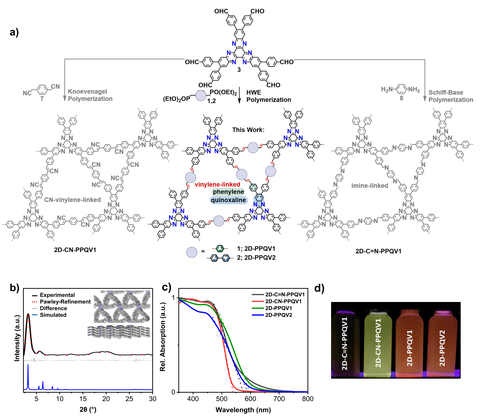Sep 29, 2020
Synthesis of Vinylene‐Linked Two‐Dimensional Conjugated Polymers via the Horner‐Wadsworth‐Emmons Reaction
Interest in linear (1D) conjugated polymers has significantly increased in recent decades due to their semiconducting properties and promising applications in organic optoelectronics. 2D conjugated polymers (2D CPs) consisting of multi-strands of linear conjugated polymers have been the dream of synthetic targets for several decades. The synthesis of 2D CPs with fully vinylene-linked backbones still lacks effective protocols to generate crystalline polymer materials. Vinylene-linked 2D CPs provide high chemical and thermal stabilities as well as complete π-conjugation over the whole 2D polymer framework, making these materials highly attractive for various applications, such as in optoelectronics, spintronics, and energy storage.
To address these synthetic challenges, a group of scientists from Technische Universität Dresden (TUD, Chair for Molecular Functional Materials) and collaborators have developed a novel methodology to synthesize 2D poly(arylenevinylene)s via a Wittig-type reaction (Horner-Wadsworth-Emmons reaction, HWE). The novel vinylene-linked 2D CPs, namely, 2D poly(phenylenequinoxalinevinylene)s 2D-PPQV1 and 2D-PPQV2, were synthesized by employing the HWE reaction between aldehyde- and phosphonate substituted monomers (Figure 1a). Powder X-ray diffraction (PXRD) studies (Figure 1b) and nitrogen adsorption-desorption measurements demonstrate the formation of proclaimed crystalline, dual-pore structures with surface areas of up to 440 m2/g. More importantly, the UV-Vis absorption (Figure 1c) and fluorescence emission (Figure 1d) of the obtained 2D-PPQV1 (Eg=2.2 eV) and 2D-PPQV2 (Eg=2.2 eV) are compared with those of cyano-vinylene-linked 2D-CN-PPQV1 (Eg=2.4 eV) produced by the Knoevenagel reaction and imine-linked 2D COF analog (2D-C=N-PPQV1, Eg=2.3 eV), unambiguously proving the superior conjugation of the vinylene-linked 2D CPs using the HWE reaction.
Figure 1: a) Synthesis of 2D-PPQV1, 2D-PPQV2, 2D-CN-PPQV1, and 2D-C=N-PPQV1; b) PXRD data of 2D-PPQV2: Experimental (black) and Pawley-refined PXRD (red), difference plot (gray), simulated PXRD with AA mismatch stacking (blue), and the model of the simulated eclipsed layer mismatch structure shown in the inset; c) UV-Vis absorption spectra of 2D-C=N-PPQV1 (black), 2D-CN-PPQV1 (red), 2D-PPQV1 (green), and 2D-PPQV2 (blue) (dispersions in 2-propanol, concentration=0.2 mg/mL); d) photographs of the fluorescence emission (λex=365 nm) of 2D-C=N-PPQV1, 2D-CN-PPQV1, 2D-PPQV1, and 2D-PPQV2.
Reference: Dominik L. Pastoetter, Shunqi Xu, Mino Borrelli, Matthew Addicoat, Bishnu P. Biswal, Silvia Paasch, Arezoo Dianat, Heidi Thomas, Reinhard Berger, Sebastian Reineke, Eike Brunner, Gianaurelio Cuniberti, Marcus Richter, Xinliang Feng*. Synthesis of Vinylene‐Linked Two‐Dimensional Conjugated Polymers via the Horner‐Wadsworth‐Emmons Reaction. Angew. Chem. Int. Ed., 2020, DOI: 10.1002/anie.202010398
Acknowledgments: This research was supported financially by the EU Graphene Flagship (GrapheneCore, No. 881603), the Collaborative Research Centre (CRC) 1415 “Chemistry of Synthetic Two-Dimensional Materials” (No. 417590517), H2020-MSCA-ITN (ULTIMATE, No. 813036), the Center for Advancing Electronics Dresden (cfaed), and the ERC Consolidator Grant (T2DCP, No. 819698).

